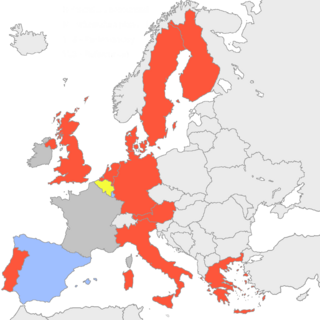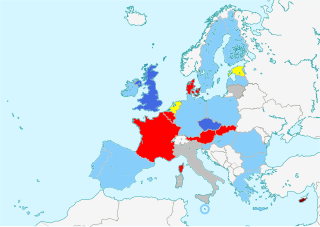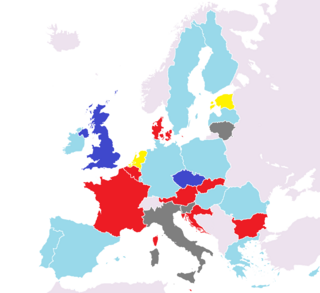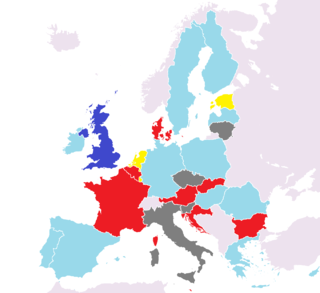
On 1 May 2004 ten new member states joined the European Union. This article describes the party affiliations of the leaders of each member-state represented in the European Council from 1 May until the end of 2004. The list below gives the political party that each head of government, or head of state, belonged to at the national level, as well as the European political alliance to which that national party belonged. The states are listed from most to least populous. More populous states have greater influence in the council, in accordance with the system of Qualified Majority Voting.

The official title President of the European Union does not exist, but there are a number of presidents of European Union institutions, including:

This article describes the party affiliations of the leaders of each member-state represented in the European Council during the year 2005. The list below gives the political party that each head of government, or head of state, belongs to at the national level, as well as the European political alliance to which that national party belongs. The states are listed from most to least populous. More populous states have greater influence in the council, in accordance with the system of Qualified Majority Voting.

Prior to 1 May 2004 the European Union had fifteen members. On that date ten new member states were admitted. This article describes the party affiliations of the leaders of each member-state represented in the European Council from the beginning of 2004 until 1 May. The list below gives the political party that each head of government, or head of state, belonged to at the national level, as well as the European political alliance to which that national party belonged. The states are listed from most to least populous. More populous states have greater influence in the council, in accordance with the system of Qualified Majority Voting.

This article describes the party affiliations of the leaders of each member-state represented in the European Council during the year 2003. The list below gives the political party that each head of government, or head of state, belonged to at the national level, as well as the European political alliance to which that national party belonged. The states are listed from most to least populous. More populous states have greater influence in the council, in accordance with the system of Qualified Majority Voting.

This article describes the party affiliations of the leaders of each member-state represented in the European Council during the year 2006. The list below gives the political party that each head of government, or head of state, belongs to at the national level, as well as the European political alliance to which that national party belongs. The states are listed from most to least populous. More populous states have greater influence in the council, in accordance with the system of Qualified Majority Voting.

This article describes the party affiliations of leaders of each member-state represented in the European Council during the year 2007. The list below gives the political party that each head of government, or head of state, belongs to at the national level, as well as the European political alliance to which that national party belongs. The states are listed from most to least populous. More populous states have greater influence in the council, in accordance with the system of Qualified Majority Voting.

This article describes the party affiliations of the leaders of each member-state represented in the European Council during the year 2002. The list below gives the political party that each head of government, or head of state, belonged to at the national level, as well as the European political alliance to which that national party belonged. The states are listed from most to least populous. More populous states have greater influence in the council, in accordance with the system of Qualified Majority Voting.

This article describes the party affiliations of the leaders of each member-state represented in the European Council during the year 2001. The list below gives the political party that each head of government, or head of state, belonged to at the national level, as well as the European political alliance to which that national party belonged. The states are listed from most to least populous. More populous states have greater influence in the council, in accordance with the system of Qualified Majority Voting.
The Government of Uttar Pradesh is a democratically elected state government in the Indian state of Uttar Pradesh with the governor as its appointed constitutional head of the state by the President of India. The Governor of Uttar Pradesh is appointed for a period of five years and appoints the chief minister and his or her council of ministers, who are vested with the executive powers of the state. The governor remains a ceremonial head of the state, while the chief minister and his or her council are responsible for day-to-day government functions. The state of Uttar Pradesh's influence on Indian politics is important, and often paramount and/or a bellwether, as it sends the most members of parliament to both the Lok Sabha and the Rajya Sabha, the state's population being more than 200 million; approximately double that of the next-most populous state.

This article describes the party affiliations of leaders of each member-state represented in the European Council during the year 2008. The list below gives the political party that each head of government, or head of state, belongs to at the national level, as well as the European political alliance to which that national party belongs. The states are listed from most to least populous. More populous states have greater influence in the council, in accordance with the system of Qualified Majority Voting.

This article describes the party affiliations of the leaders of each member-state represented in the European Council during the year 2000. The list below gives the political party that each head of government, or head of state, belonged to at the national level, as well as the European political alliance to which that national party belonged. The states are listed from most to least populous. More populous states have greater influence in the council, in accordance with the system of Qualified Majority Voting.

This article describes the party affiliations of the leaders of each member-state represented in the European Council during the year 1999. The list below gives the political party that each head of government, or head of state, belonged to at the national level, as well as the European political alliance to which that national party belonged. The states are listed from most to least populous. More populous states have greater influence in the council, in accordance with the system of Qualified Majority Voting.

This article describes the party affiliations of leaders of each member-state represented in the European Council during the year 2009. The list below gives the political party that each head of government, or head of state, belongs to at the national level, as well as the European political alliance to which that national party belongs. The states are listed from most to least populous. More populous states have greater influence in the council, in accordance with the system of Qualified Majority Voting.

This article describes the party affiliations of leaders of each member-state represented in the European Council during the year 2010. The list below gives the political party that each head of government, or head of state, belongs to at the national level, as well as the European political alliance to which that national party belongs. The states are listed from most to least populous. More populous states have greater influence in the council, in accordance with the system of Qualified Majority Voting.

This article describes the party affiliations of leaders of each member-state represented in the European Council during the year 2012. The list below gives the political party that each head of government, or head of state, belongs to at the national level, as well as the European political alliance to which that national party belongs. The states are listed from most to least populous. More populous states have greater influence in the council, in accordance with the system of Qualified Majority Voting.
This article describes the party affiliations of the leaders of each member-state represented in the European Council during the year 1998. The list below gives the political party that each head of government, or head of state, belonged to at the national level, as well as the European political alliance to which that national party belonged. The states are listed from most to least populous. More populous states have greater influence in the council, in accordance with the system of Qualified Majority Voting.

Until 1 July 2013 the European Union will have twenty-seven members. On that date, Croatia is expected to join the Union, therefore forcing a change of the influence each member-state has, as well as its Qualified Majority Voting. This article describes the party affiliations of leaders of each member-state represented in the European Council during the year 2013. The list below gives the political party that each head of government, or head of state, belongs to at the national level, as well as the national level to which that national party belongs. The states are listed from most to least populous. More populous states have greater influence in the council, in accordance with the system of Qualified Majority Voting.

Since 1 July 2013 the European Union have twenty-eight members. Croatia joined the Union, therefore forcing a change of the influence each member-state has, as well as its Qualified Majority Voting. This article describes the party affiliations of leaders of each member-state represented in the European Council during the year 2013. The list below gives the political party that each head of government, or head of state, belongs to at the national level, as well as the European political alliance to which that national party belongs. The states are listed from most to least populous. More populous states have greater influence in the council, in accordance with the system of Qualified Majority Voting.

This article describes the party affiliations of leaders of each member-state represented in the European Council during the year 2014. The list below gives the political party that each head of government, or head of state, belongs to at the national level, as well as the European political alliance to which that national party belongs. The states are listed from most to least populous. More populous states have greater influence in the council, in accordance with the system of Qualified Majority Voting.


















